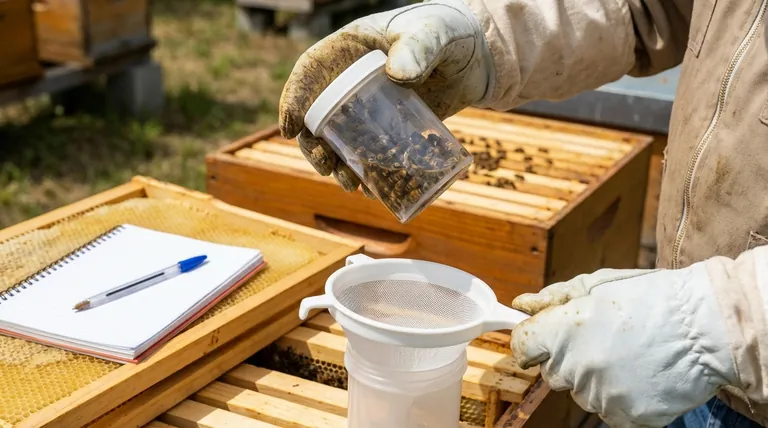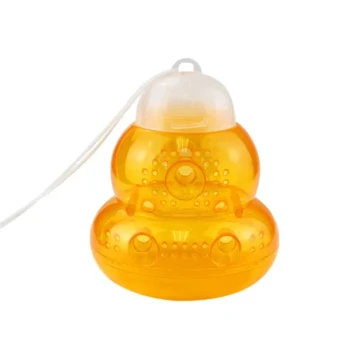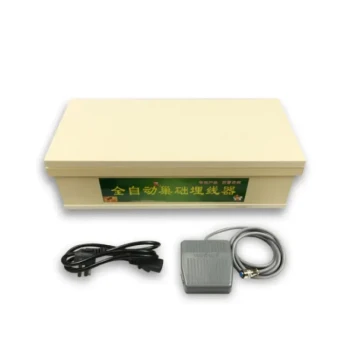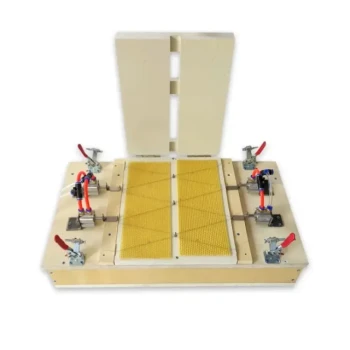To effectively monitor Varroa mites, beekeepers use several established methods to measure infestation levels within a colony. The most common are the alcohol wash, powdered sugar roll, CO2 injection, and the sticky board. Each technique provides a quantifiable metric—either as a percentage of mites per 100 bees or a total mite drop over 24 hours—that allows you to make an informed decision about whether treatment is necessary.
Monitoring for Varroa mites is not simply about counting; it is a critical diagnostic tool for colony health. The objective is to obtain an accurate infestation rate so you can intervene with treatments before the colony shows irreversible signs of damage and collapse.

The Two Main Approaches to Monitoring
The methods for counting mites fall into two distinct categories. Understanding the difference is key to interpreting your results correctly.
Category 1: The Phoretic Mite Snapshot
These methods count the phoretic mites—those riding on the bodies of adult bees. They provide an immediate "snapshot" of the mite load on a sample of your adult bee population. A standard sample size is approximately 300 bees (a level 1/2 cup).
Alcohol Wash: The Gold Standard for Accuracy
The alcohol wash is considered the most accurate method. It involves collecting a sample of bees in a jar with rubbing alcohol and shaking it to dislodge the mites.
Because this method kills the mites and the bees in the sample, it guarantees all mites are dislodged for a precise count. While it requires sacrificing a small number of bees, this loss is insignificant compared to losing an entire colony to a mite infestation.
Powdered Sugar Roll: The Live-Bee Alternative
The sugar roll follows a similar process but uses powdered sugar instead of alcohol. The fine sugar particles cause the mites to lose their grip, and they are shaken out through a mesh screen for counting.
The primary benefit is that the bees in the sample can be returned to the hive. However, this method is known to be less accurate than the alcohol wash and may under-report the true mite level.
CO2 Injection: A Fast, Live-Bee Method
This technique uses a specialized device to anesthetize a bee sample with CO2. The unconscious mites and bees are then shaken, and the mites fall through a screen for counting.
Like the sugar roll, it does not kill the bees. It is faster than a sugar roll but requires specific equipment, and its accuracy can vary.
Category 2: The Passive Mite Drop
This approach provides a more general, passive measure of the mite population over time.
Sticky Board: The Non-Invasive Indicator
A sticky board (a gridded sheet coated with a sticky substance) is placed on the bottom board of the hive for a set period, typically 24-72 hours. You then remove it and count the number of mites that have naturally fallen from the bees above.
This method is completely non-invasive. However, it is considered the least reliable for making critical treatment decisions, as the natural mite drop can be influenced by weather, the amount of brood in the hive, and other factors.
Understanding the Results and Thresholds
Counting mites is useless without knowing what the numbers mean. The goal is to compare your result to an established "action threshold."
Calculating Your Mite Infestation Rate
For the alcohol wash, sugar roll, or CO2 method, you calculate the infestation rate as a percentage. The formula is simple:
(Number of Mites ÷ Number of Bees in Sample) x 100 = % Mite Infestation
For a standard 300-bee sample, if you count 6 mites, your infestation rate is 2%. (6 ÷ 300) x 100 = 2%.
Acting on Thresholds
An action threshold is the mite level at which treatment is recommended to prevent economic or population damage. These thresholds are not static; they change throughout the year.
For example, a 2-3% infestation may be acceptable in the late summer, but that same level in the early spring requires immediate action. Always consult up-to-date regional guides, such as the Honey Bee Health Coalition's "Tools for Varroa Management," for current recommended thresholds.
The Critical Importance of Timing
When you monitor is just as important as how you monitor. Doing nothing is not a viable management strategy.
The Ideal: Monthly Checks
Monitoring once a month from spring through fall gives you the clearest picture of your mite population's trajectory. This frequency allows you to catch rising mite levels early and act decisively.
The Minimum: Key Seasonal Monitoring
If monthly checks are not possible, you must monitor at least four times a year during critical phases of the colony's lifecycle:
- Early Spring: Before the population begins its rapid expansion.
- Late Spring/Early Summer: As the population is increasing.
- Mid-to-Late Summer: After the peak population and main honey flow.
- Fall: Before the colony produces the vital winter bees that must survive until spring.
Understanding the Trade-offs and Risks
Choosing a monitoring method involves balancing accuracy against other factors. The consequences of getting this wrong can be severe.
The Risk of Inaccuracy
While the sugar roll saves the bees in your sample, its tendency to under-report mite levels presents a significant risk. Mistakenly believing your mite load is low can lead to delaying treatment, which can be a fatal error for the colony. The small, controlled loss of 300 bees in an alcohol wash is a worthy trade-off for data you can trust.
The Stages of Mite Damage: What You're Preventing
Failing to monitor and treat leads to a predictable pattern of colony decline. Your goal is to intervene before you see these signs.
- Stage 1: No visible signs of mites or disease.
- Stage 2: You begin to see phoretic mites on adult worker or drone bees.
- Stage 3: You see signs of Chewed Down Brood as bees try to remove infested pupae.
- Stage 4: Deformed Wing Virus (DWV), a classic sign of a high mite load, appears.
- Stage 5: The colony collapses from Varroa Mite Syndrome—a cascade of viruses and a dwindling, sick population.
Making the Right Choice for Your Colony
Your choice of monitoring method should align with your management philosophy and tolerance for risk.
- If your primary focus is maximum accuracy to protect your colonies: The alcohol wash is the undisputed standard for making reliable, data-driven treatment decisions.
- If your primary focus is avoiding any harm to bees, and you accept lower accuracy: The powdered sugar roll is a viable, non-lethal alternative, but you should treat more conservatively based on its results.
- If your primary focus is a passive, general sense of mite levels: The sticky board can be a useful background indicator, but it should not be the sole method used for making time-sensitive treatment decisions.
Ultimately, consistent monitoring with an understood method is infinitely better than no monitoring, as it empowers you to protect your bees before it is too late.
Summary Table:
| Method | Type | Accuracy | Bee Mortality | Key Use Case |
|---|---|---|---|---|
| Alcohol Wash | Phoretic Snapshot | High (Gold Standard) | Yes (Sample) | Accurate treatment decisions |
| Powdered Sugar Roll | Phoretic Snapshot | Moderate | No | Non-lethal alternative |
| CO2 Injection | Phoretic Snapshot | Moderate | No | Fast, live-bee method |
| Sticky Board | Passive Drop | Low | No | General background indicator |
Protect Your Apiary with Confidence
Accurate mite monitoring is the foundation of successful colony management. HONESTBEE supplies commercial apiaries and beekeeping equipment distributors with the high-quality, reliable supplies needed to implement these critical monitoring protocols effectively.
From precision sampling jars for alcohol washes to durable hive bottom boards for sticky board monitoring, our wholesale-focused operations ensure you have the right tools to make data-driven decisions and prevent colony collapse.
Contact HONESTBEE today to discuss your apiary's supply needs and ensure your monitoring program is built on a foundation of quality equipment.
Visual Guide

Related Products
- Adjustable Formic and Acetic Acid Dispenser for Bee Mite Treatment
- Professional Bamboo Queen Isolation Cage
- Gourd Shaped Hanging Wasp Trap Professional Wasp Catcher
- Professional Adjustable Timer Electric Wire Embedder
- Professional Pneumatic Wire Embedder for Beehive Frames
People Also Ask
- What does Chewed Down Brood (CDB) indicate in bee colonies? A Sign of Varroa Mite Infestation
- What should beekeepers do to manage varroa mites effectively? Adopt a Proactive Monitoring Strategy
- What are the symptoms of Varroa Mite Syndrome (VMS)? Recognizing the Signs of Colony Collapse
- How do Varroa mites spread between honey bee colonies? Stop Mite Transmission in Your Apiary
- What is the focus of hive management during summer? Maximize Your Honey Harvest with Expert Tips



















